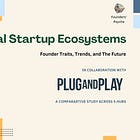Japan’s Startup Reboot: A Conversation with Plug and Play’s Phillip Vincent
From deep tech to healthcare, how Japan’s startup landscape is being reshaped—inside and out.
At Founders’ Psyche, we had the opportunity to speak with Phillip Vincent, Managing Director of Plug and Play Japan, who brings over a decade of experience bridging startup ecosystems between Japan and Silicon Valley. As a bilingual, bicultural leader who has helped launch Plug and Play’s Japan operations, Phillip offers a rare inside look into one of the world’s most quietly ambitious tech ecosystems. From overseeing partnerships with 40+ Japanese corporates to building programs in deep tech and healthcare, he’s played a key role in shaping Japan’s entrepreneurial landscape over the past seven years.
This blog was part of study I did with Plug N Play Tech Center where we comapred 5 regional startup ecosystems. You can check it out here -
In this conversation, we explored how Japan’s startup ecosystem has evolved, how cultural factors shape founder behavior, and what’s next for one of Plug and Play’s largest offices outside the U.S.
Plug and Play Japan: A Bridge Between Ecosystems
Phillip's journey into venture-backed innovation started in Silicon Valley, but it was his deep ties to Japan’s corporate world that led him to launch Plug and Play Japan in 2017. What started as an experiment in cross-border collaboration has grown into a 70-person operation, with offices in Tokyo, Osaka, and Kyoto, and a network of over 40 corporate and government partners.
“Japan is now our largest market outside of the U.S.,” Phillip shares. “We’re seeing growing interest from both corporates and government in innovation—and that’s a big shift.”
What Each Region Brings to the Table
Tokyo remains Japan’s beating economic heart, where over 90% of startup and corporate activity takes place. Every major vertical—from fintech to mobility—is represented here.
Kyoto, with its strength in hardware, semiconductors, and life sciences, is a hub for industrial innovation and university collaborations.
Osaka, Japan’s second-largest city, plays a supportive role, especially in government-driven initiatives. It’s also preparing to host the World Expo in 2025, a key milestone for Plug and Play’s regional presence.
Where Japan’s Innovation is Heading
Among the seven verticals Plug and Play focuses on in Japan, Phillip highlights two as fast-rising:
Deep Tech: Bolstered by strong university research and new government funding, deep tech has become a national priority.
Health & Biotech: With increasing investment and policy momentum, this sector is growing quickly—especially post-COVID.
Japan’s five-year startup development plan, launched in 2022 by the federal government, aims to 10x the number of startups, unicorns, and total investments. “It’s the first time the government has taken this seriously,” says Phillip. “And that’s changed how even the private sector now views working with startups.”
COVID’s Impact: A Shift in Mindset, Not Just Market
While COVID did not radically reshape Japan’s startup landscape, it accelerated some key changes:
Remote work became more normalized in a traditionally conservative work culture.
Sectors like telemedicine and e-commerce saw increased momentum.
Startups saw greater urgency in tackling inefficiencies and building digital solutions.
But perhaps more important than market effects, COVID exposed structural gaps in startup readiness, prompting government and industry to lean more into innovation.
The Investment Approach: Global Standards, Local Nuance
Plug and Play Japan has invested in 21 startups over the past five years, with plans to increase that number to 10–15 annually starting this year. Their focus aligns with global Plug and Play strategy—pre-seed to seed stage, B2B or B2B2C, and startups that want to scale internationally.
Interestingly, Phillip notes that about half their investments come through cold outreach or proactive scouting, a higher ratio than other Plug and Play regions like Germany or Canada, where warm intros dominate.
The Japanese Founder Persona: Strengths and Challenges
Japanese founders bring clear strengths—discipline, reliability, and a deep respect for structure—but also face hurdles:
Risk aversion and fear of failure often inhibit bold experimentation.
Limited exposure to global startup culture leaves many without playbooks for scaling or fundraising.
Solo and serial founders are still rare, with most viewing startups as a lifelong commitment rather than a stepping stone.
“There’s still a lack of role models,” Phillip explains. “And that limits how people imagine their entrepreneurial journey.”
Supporting Mindset Shifts
Plug and Play Japan is addressing these gaps in subtle but powerful ways:
Programs that mix 50% international and 50% Japanese startups expose founders to new thinking and pitching styles.
Government-funded tracks help startups prepare for international expansion, from market research to go-to-market planning.
While the team doesn’t yet offer structured mental health support, they recognize the stress founders face—especially in a high-performance culture like Japan’s.
Looking Ahead: 2025 and Beyond
Over the next five years, Phillip expects Japan’s ecosystem to move from “behind” to globally relevant, especially as deep tech, healthcare, and AI gain momentum.
“The government push has created real energy,” he says. “But there’s still a cultural lag when it comes to adoption, especially in AI and SaaS. The urgency to change isn’t always there.”
Still, with growing investor interest, stronger government backing, and Plug and Play’s expanding presence, Japan is no longer an afterthought in global innovation—it’s becoming a destination.


